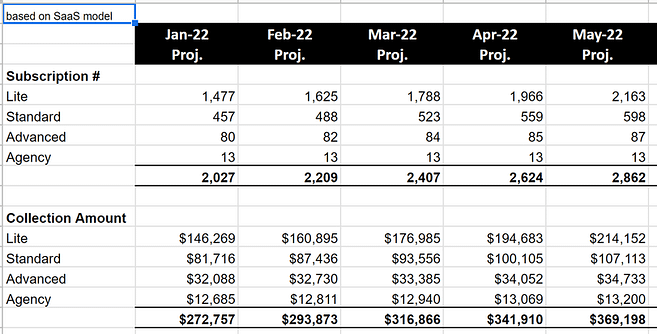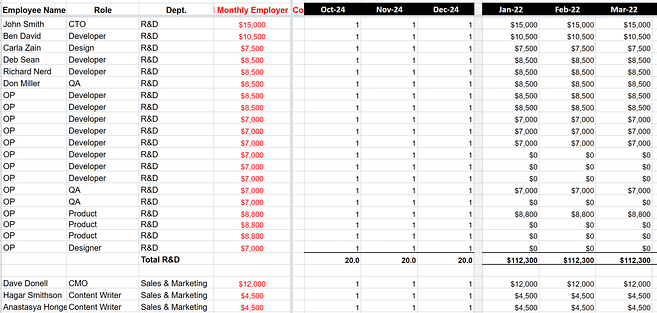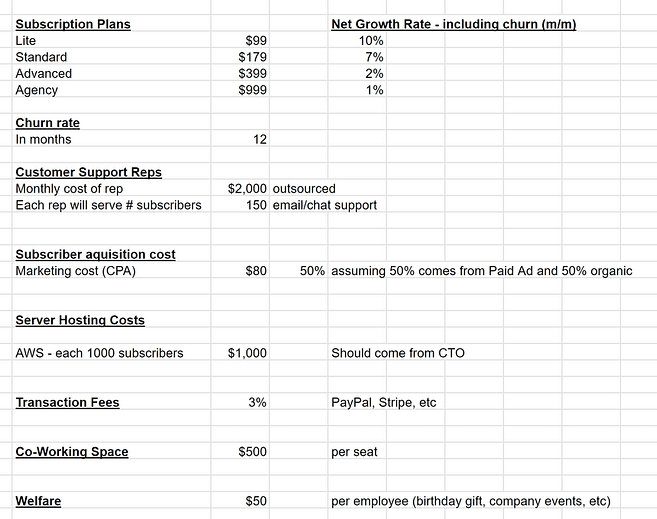Financial projection (other names are: budget plan or financial model or financial planning) is an essential part of any startup that needs to run its numbers and also raise venture capital.
By creating a detailed projection that accounts for all possible risks and rewards, you can show potential investors that your startup is worth their time and money.

There are a few key things that potential investors look for in financial forecasts when it comes to venture capital.
They want to see that your startup has a clear path to traction and profitability, and they also want to know that you have a detailed understanding of your financial situation.
This article will provide you with free templates and tips to help you create startup financial projections that will attract investors in 2022.
What Is A Startup Financial Projection
A startup’s financial projection represents the future income and outgoings of the company alongside historical data as a reference.
They can be used to estimate future revenue, profits and losses, and are an essential tool for startup owners when trying to secure investment.
Startup financial projections should account for all possible risks and rewards and should be as accurate as possible.
It’s important to remember that these forecasts are not set in stone – they will likely change as your startup grows and evolves.
Making projections often involves developing versions of underlying financial statements such as cash flow statements, income statements, and balance sheet reports.
The assumptions and estimates used in these statements will have a large impact on the forecasted results.
Why Startup Business Owners Need A Financial Projection
Creating financial projections is an integral part of the business plan for startups.
It helps them understand how much money they will need and when required.
It also helps them know how much money they can expect to make and when it will be made.
Startup financial projections can also help a startup attract investors.
By showing potential investors that you clearly understand your startup’s financial situation, you can demonstrate that you are a responsible and capable entrepreneur.
A financial projection is a forecast of a company’s expected financial performance over a set period of time, typically three years (in some cases even five years).
This includes both cash flow projections and balance sheet projections.
This forecast is usually used in conjunction with other business plan components, such as the marketing strategy, operations strategy, staffing requirements, and expansion plans to help establish goals for the company over time.
What Investors Are Looking For In Financial Projection
When creating startup financial projections, there are a few key things to consider.
First, you need to make sure that your projection is realistic.
This means accounting for all possible risks and rewards, not just the most optimistic scenario.
Make sure that your financial projections are easy to follow and understand.
Potential investors don’t have time to understand a cumbersome, complicated document.
You need to keep it simple yet profound, that’s the power of a great financial projection.
At the heart of it, the financial projection should tell a compelling story of your startup’s ability to gain massive market traction over a specific period of time.
Remember that investors care about one thing, and one thing only, ROI.
This is why your projection should be aggressive yet explainable to any sophisticated investor.
If you can convince them through your financial projection, that there is a good chance of a great ROI, they will go for it.
Finally, you need to make sure that your startup financial projection is updated regularly.
By keeping your projection up to date, you can show potential investors that you are a responsible and capable entrepreneur; as your startup grows and changes, so will your financial situation.
What Kind Of Reports Do You Need To Prepare
The most basic report is Profit and Loss (or income statement) which describes the startup’s revenue and expenses over time.
This report is important because it shows the startup’s ability to generate profits and covers all aspects of the startup’s expenses.
Another important report is the Balance Sheet, which provides an overview of the startup’s assets (i.e. accounts receivable, liabilities (i.e. accounts payable, and equity at a specific point in time.
The balance sheet is important because it shows the startup’s financial stability and its ability to pay its debts.
The last report is the Cash Flow Statement, which shows how the startup’s cash inflows and outflows over time.
The cash flow statement is important because it shows the startup’s ability to generate cash and its liquidity.
Investors will seek to see the P&L projection over 3 or 5 years, this is the most important report you’ll prepare. In addition, some investors will ask for Cash Flow projection as well. Rarely do I see investors who asked for a Balance Sheet projection.
5 Core Components Of A Great Financial Projection
A startup financial model should include startup revenue and expenses projection over time.
The basis for this projection is profit and loss and also cash flow statements.
Here are five key pieces of information you should consider to include in your projection:
P&L Summary

this tab summarizes the revenue and expenses and EBIDTA, it pulls the numbers from the P&L Details tab.
It’s an easy-to-digest table that presents your sales projection and planned expenses so any investor can get a simple 10000 feet view of your financials.
Here is a snapshot of what it should look like:
P&L Details
This tab includes all revenue and expenses by line item, on a monthly basis for the whole period, whether it’s 3 or 5 years projection.

The right breakdown of the P&L, and the one mature companies like Slack use is as follows (by order):
- Revenue: all streams of revenue by product or package, for example, if you have a SaaS product with 3 packages (silver, bronze and gold) you will present all 3 separately.
- COGS/COS: stands for ‘cost of sales’, ‘cost of goods sold’. COGS is relevant for companies who manage inventory, otherwise, you will use COS (for example if you are a SaaS company). These are all expenses that have a direct relation to sales. such as customer support team salary, professional services, and technical operations staff, payments to outside service providers, third-party hosting costs (AWS, Azure, etc), payment processing fees, etc
- Research & Development: all expenses that relate to your R&D team, developers and Q&A salary, product team salary, outsourced consultants, R&D tax credits, IP, etc
- Sales & Marketing: all expenses related to your marketing and sales efforts, sales rep salary, marketing rep salary, sales consultants, marketing efforts such as: PR, paid ad, SEO, conferences, travel, etc
- General & Administrative: here we will include all overhead expenses like office lease and related expenses, office supply, insurance, professional services (accounting, legal, HR, etc), travel, etc. In addition, here we will include CEO salary together with the office manager’s and other general employees’ salary.
Revenue Model
one of the most important elements in each financial projection is your revenue model which describes your way of getting sales from your customers.
This model describes the different pricing points, subscription types, upsells and cross-sells, discounts, and any other features you may have in your sales process.

The goal is to have a complete understanding of how you will make money from your customers so you can project the revenue and corresponding expenses accurately.
The 3 main types of revenue models are subscription, usage, and transaction.
1- Subscription: the customer pays a recurring fee for a certain service or product
2- Usage: the customer pays a fee each time they use your service or product
3- Transaction: the customer pays for every transaction they make with you
Headcount
In this tab, we will describe our current headcount, based on your employee’s position, department, date of hire, and total employer cost.
In addition, we will also include future hires based on our business model projection and resources needed to reach our revenue and profitability targets.

Assumptions
This is one of the most important tabs in the financial projection as it includes all the assumptions we made when building the model.
These assumptions will include:
– Revenue growth: how much you expect your startup to grow each year, this number should be based on your market research and understanding of the business.
– Expense growth: how much you expect your expenses to grow each year, this number should also be based on your research and understanding of the business.
– Gross margin: what percentage of each dollar of revenue you will keep as profit
– Headcount growth: how many employees you will add in each year, based on your business model
– Customer churn: what percentage of your customers will leave each year
– Sales cycle: how long it takes on average to close a deal with a customer
– Discounts: any discounts you offer to customers
– Upsells and cross-sells: any additional products or services you sell to your customers
You should strive to keep your financial projection flexible to changes by keeping your key metrics as variables that could change based on market signals.
In addition, it will help you create realistic financial projections vs optimistic scenarios.

What Tools Should You Use To Build The Financial Projection?
There are many different ways you can build your startup financial projection.
You can use a simple Excel file, Google Spreadsheet, or even specialized software tools designed for startup financial projections.
Using Excel or Google Spreadsheet is easy, simple, and free but requires also manual work and can take you more time to prepare.
Using software tools come with pros and cons. The pros are slick design, organized framework, fast implementation, immediate export of reports, and more. Cons can be limitations of projection structure, complexity, cost, etc.
My recommendation is to use excel as some investors don’t use Gmail thus won’t be able to get your shared link, and if you use Google Spreadsheet, some of the design will be lost when converting to Excel.
Financial Forecasting Tips To Remember
Creating an accurate financial forecast can be difficult even if the business is not currently running independently. There might be no historical numbers that will allow you better understand future projections.
However, you may have enough market research to make a realistic forecast. Let me list a couple of possible strategies.
– Use market trends: your startup is not the only one that will be affected by market trends, so using data and information about past, current, and future market trends can help you make better projections
– Use surveys and customer interviews: if you have access to survey data or interviews with your target market, it can give you a good idea of what to expect in the future.
– Use public companies: if there are any similar public companies in your industry, you can learn from their past performance to get an idea of what to expect in the future.
– Use expert opinion: ask for help from people who have been in the industry for a long time or have started a similar business in the past, they might be able to provide you with some good insights.
– Use your gut: sometimes, after doing all the research, you will still have to make a decision based on your intuition, and that’s okay.
When creating your startup financial projection, there are a few things to keep in mind:
– Be realistic: remember that your projections are just that – projections. They may not be exactly what happens, so be reasonable in your estimates
– Keep it simple: the less complex your projection is, the easier it will be to understand and the more likely investors will be to take a look.
– Update regularly: as your business grows and changes, so should your projection. Be sure to update it at least once a year, or more often if there are major changes in your business model
– Have different scenarios: create a few different projections based on different assumptions, such as optimistic, realistic, and pessimistic scenarios. This will show investors that you have thought about different outcomes and how your business would be affected
– Get help if you need it: if you’re not sure where to start or what assumptions to make, seek out help from someone with experience in startup financial projections.
Important KPIs You Should Familiarize Yourself With
If you want to build a robust startup financial projection that attracts investors, you need to familiarize yourself with important KPIs. KPIs are key performance indicators that help you track the success of your company. Some essential KPIs to know include:
- MRR (Monthly Recurring Revenue) is a key performance indicator that represents the amount of predictable revenue generated by a startup’s subscription-based model each month.
- ARR (Annual Recurring Revenue) is a metric that represents the amount of predictable revenue generated by a startup’s subscription-based model annually. This metric is important for long-term financial projections and attracting investors.
- CAC (Customer Acquisition Cost) is the amount of money a startup spends on acquiring a new customer. This metric helps determine the effectiveness of a startup’s marketing and sales efforts.
- Churn is the percentage of customers who stop using a startup’s product or service over a given period of time. A high churn rate can negatively impact a startup’s revenue and growth prospects.
- Financial Runway is the length of time a startup can continue operating based on its current cash balance and burn rate. This metric helps investors evaluate a startup’s financial stability.
- LTV (Customer Lifetime Value) is the estimated total revenue a startup can expect to earn from a single customer over the course of their relationship. This metric helps a startup determine the value of acquiring and retaining customers.
- ROI (Return on Investment) is a measure of the profit or loss generated by an investment. This metric helps investors evaluate the potential return on their investment in a startup.
- P&L (Profit and Loss) is a financial statement that shows a startup’s revenue, expenses, and net profit or loss over a specific period of time. This statement helps a startup understand its financial performance.
- Balance Sheet is a financial statement that shows a startup’s assets, liabilities, and equity at a specific point in time. This statement helps investors evaluate a startup’s financial health.
- Cash Flow Statement is a financial statement that shows a startup’s cash inflows and outflows over a specific period of time. This statement helps a startup understand its ability to generate cash and meet its financial obligations.
Conclusion
A startup financial projection is an essential part of the business plan for startup businesses. It helps them understand how much money they will need and when required.
It also helps them know how much money they can expect to make and when it will be made. Startup financial projection can also help a startup attract investors.
By showing potential investors that you clearly understand your startup’s financial situation, you can demonstrate that you are a responsible and capable entrepreneur.
